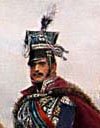It was discovered during this time in Osnabrück, that many of the other szlachta were either in the region or very nearby, stemming from their connection to the 30 years war conclusions. While in no way could a formal Diet be called in the foreign lands of Bavaria, Elector Maxmilian I was willing to oversee an informal discussion relating to the selection of a future Duke and to confirm the expulsion of Cardinal Dobry, forbidding his return under pain of punishment to be meted out by the Bavarian ruler.

Upon the conclusion of the peace, in 1648 the Coronet Korps was released from all dutied and fetted as many were in Bavaria.
Pułkownik Ludwik had accepted his szlachta appointment and agreed to lead the Coronet Korps back to Mieczyslaw.
Ahead of the Coronet Korps columns the szlachta, less Ludwik had pressed on into the Duchy of Mieczyslaw. Their aim was both to form a Diet and to announce the pending arrival of the Coronet Korps.










